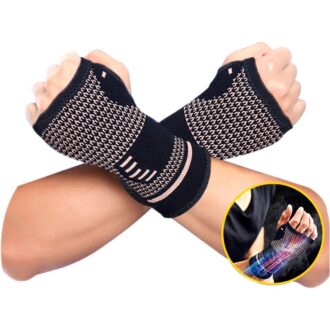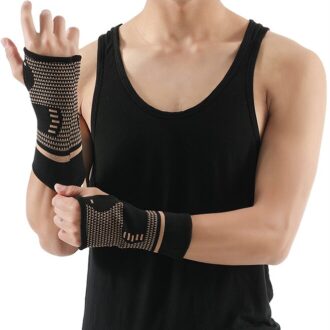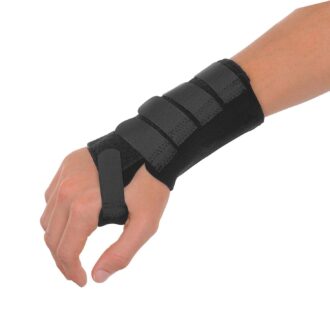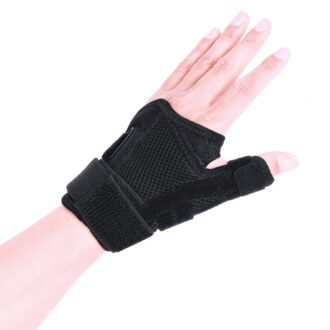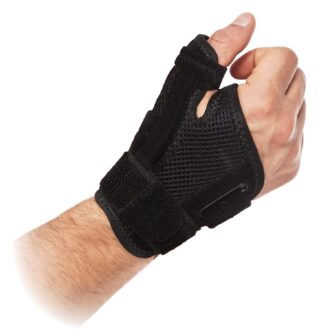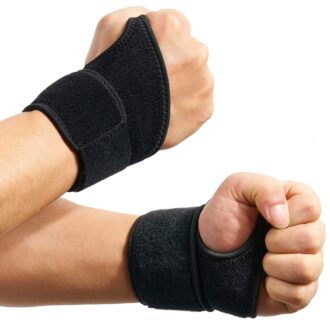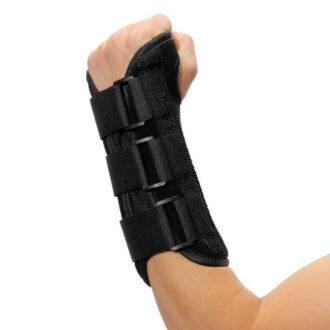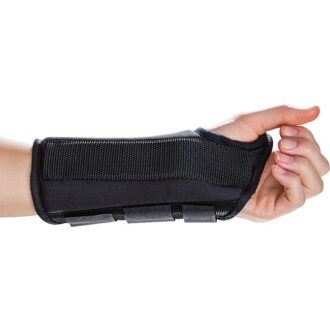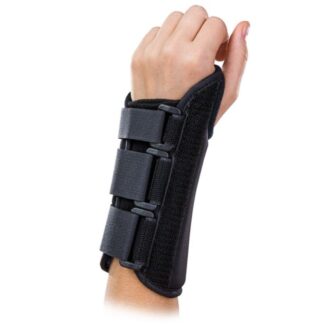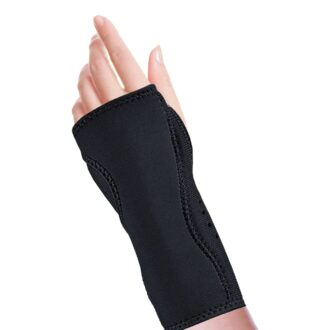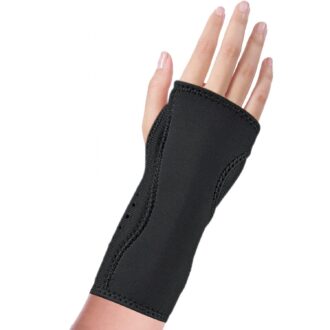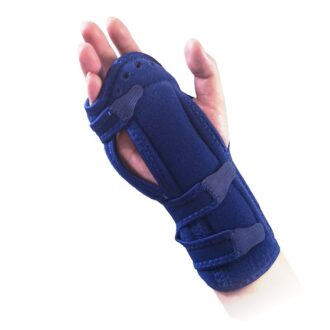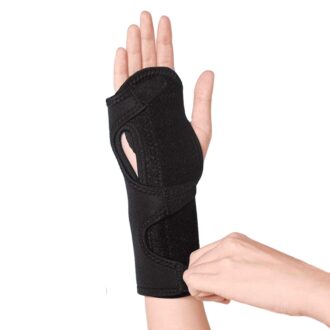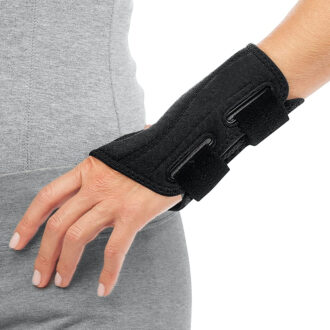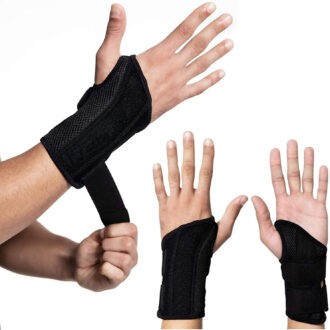Wrist Supports
Welcome to our wrist support and braces section, where we are dedicated to providing quality solutions for your wrist and hand injuries. We know how debilitating these injuries can be, not just physically but emotionally too. The constant pain, the restricted mobility, the interference with your everyday tasks – it’s enough to test anyone’s spirits. If you’re going through this, we understand your struggle and we’re here to help.
Understanding Wrist Pain
Our hands and wrists are composed of intricate networks of tendons, ligaments, and bones. An injury to any of these components can result in conditions like Wrist Sprains and Strains, Tendonitis, Repetitive Strain Injuries (RSI), Carpal Tunnel Syndrome, Wrist Fractures, Gout, Osteoarthritis and Rheumatoid Arthritis.
Wrist Sprains and Strains usually occur due to a sudden force or twist, often during sports or a fall. Tendonitis is an inflammation of the tendons due to overuse or aging. Repetitive Strain Injuries (RSI) are caused by repetitive motions or prolonged exertion. Carpal Tunnel Syndrome arises when the median nerve, which runs through the wrist, is compressed. Wrist Fractures are typically due to high impact injuries. Conditions like Gout, Osteoarthritis, and Rheumatoid Arthritis are chronic and mainly affect older individuals, causing inflammation and pain in the joints.
The key to proper recovery is the right support for the injured area to provide stability and promote healing. This is where our wrist supports and braces come into play. With diverse designs tailored to treat specific injuries, these supports offer the necessary immobilization, compression, or support to your hand and wrist, enhancing the healing process.
Enhancing Wrist Function and Reducing Strain
Here at NuovaHealth, our wrist supports and braces are expertly designed to provide essential support that significantly improves wrist function and reduce pressure on the injured area, which not only minimizes pain but also improves wrist mobility. By offering the necessary support, our wrist braces prevent further injury and allow injured tissues to rest and recuperate, facilitating a smoother recovery process.
The Role of Immobilization
One of the most crucial functions of wrist supports and braces is immobilization. By stabilizing the wrist, these supports prevent any movement that could cause further damage. Immobilization ensures that the wrist heals in a correct, straight position rather than becoming deformed. This is especially important for injuries like fractures or severe sprains, where improper healing can lead to long-term complications.
The Role of Compression
Another essential benefit of wrist supports and braces is the compression they provide. This compression boosts blood flow to the injured area, reducing inflammation and swelling, and in turn easing pain while accelerating the healing process. A 2019 study conducted by the University of Michigan found that compression therapy could reduce swelling by up to 30% within the first 24 hours post-injury. Enhanced blood flow brings more oxygen and nutrients to the injured tissues, promoting faster recovery.
Conditions Our Wrist Supports and Braces Can Help With:
Why Choose NuovaHealth
At NuovaHealth, we not only provide high-quality products but also a service that is professional, friendly, and dedicated. Our customer service team is always ready to help you with any queries or concerns that you may have.
We believe in the efficacy of our products, and hence offer a full 30-day money-back guarantee. This means that if you’re not satisfied with the product, you can return it within 30 days for a full refund. This is our promise and commitment to you.
Your well-being is our priority. We understand the emotional toll that an injury can take and we’re here to provide not just physical but emotional support as well. We want to be a part of your healing journey, offering solutions that help you regain your daily life and mobility.
Navigating through wrist pain or injury can be daunting and frustrating. However, with NuovaHealth by your side, you are not alone. Let us journey together towards your full recovery and return to a life free from pain and limitations. Welcome to a world of support, welcome to NuovaHealth.
So, browse through our range of wrist supports and braces, and let’s take the first step towards recovery together.
-
Copper Wrist & Hand Support Compression Sleeves
- 1x pair of Copper infused wrist and hand support compression sleeves for easing aches and pains
- For both Men & Women
- Available sizes Small, Medium & Large
- Lightweight breathable design with infused copper to help kill bacteria to keep your hands sweat free and feeling fresh all day long
- Perfect for wearing whilst playing sports and exercising at the gym
- Recommended for easing hand and wrist injuries including Arthritis, Carpal tunnel syndrome, Tendonitis, Sprains & Repetitive strain injuries
- Soothing compression helps boost blood flow to your hands and wrists aiding the natural healing process
- Designed to improve wrist stability and function preventing further wear and tear to damaged and injured wrists
- Made from premium quality blend of Copper, Nylon & Spandex material
- Washing instructions: Can be machine washed at a low temperature or hand washed in hot soapy water and left to dry to better maintain the stretch of the fabric – Copper fibres will help to kill bacteria and reduce odour however it is still advised to regularly wash the wrist sleeves and keep them clean
- Includes a full 30 day money back guarantee for total customer peace of mind!
£11.99inc VAT -
Copper Compression Wrist & Hand Support Sleeves for Wrist Tendonitis & Arthritis
- 1x Pair of Copper Compression Wrist & Hand Support Sleeves for Wrist Tendonitis & Arthritis
- For both Men & Women
- Available sizes Small, Medium & Large
- Ideal for providing injured wrists with extra support, stability and protection to help you make a full and faster recovery
- Can be worn to help treat and prevent Wrist Tendonitis, Arthritis, Gout, Carpal tunnel syndrome, Sprains & Repetitive strain injuries
- Promotes optimum wrist and hand movement and function to help prevent excessive strain and pressure from causing pain and injury to your hand and wrist
- Provides soothing targeted compression to your hands and wrists helping to improve blood circulation, reduce inflammation and swelling, ease pain and speed up the natural healing process of damaged tissue
- Made from a high quality blend of Copper, Nylon & Spandex material that has antibacterial properties to help kill bacteria and germs and keep you hands free from sweat and odour, dry and feeling fresher for longer
- The lightweight, breathable and durable design of these wrist sleeves makes them ideal for wearing whilst playing sports, exercising or for your daily activities
- Includes a full 30 day money back guarantee for total customer peace of mind!
£11.99inc VAT -
Wrist Support Brace for Carpal Tunnel And Fractures
- 1x Wrist Hand Support Brace
- For both Men & Women
- Available in sizes Small, Medium and Large
- Recommended for treating Tendinitis, Carpal Tunnel Syndrome, Arthritis, Strains and Sprains
- Features a removable metal splint that helps immobilize and straighten your wrist
- Provides compression support to help relieve pressure on tendons
- Made from Lightweight, breathable material to keep your wrist feeling fresh and comfortable all day long
- 5 adjustable straps per splint to help keep brace firmly in place
- Includes a full 30 day money back guarantee, no questions asked!
£12.99inc VAT -
Thumb Fracture Splint
- 1x Thumb Fracture designed to support, compress, stabilize and protect your thumb for fast and effective thumb injury recover
- One size fits all (Features fully adjustable Velcro straps that wrap around your hand for a secure and comfortable fit)
- For both Men & Women
- Fits both the left & right hand
- Features a metal Spica splint that holds and immobilizes your thumb and wrist in a straight neutral position preventing movement which could cause further damaged to your injured thumb and hinder your recovery
- Provides targeted support and compression that soothes aches and pain, reduces inflammation and swelling and boosts blood flow to your injured thumb to speed up the natural healing process of damaged tissue
- Made from soft comfortable padded materials with moisture wicking properties and breathable ventilation holes that will help keep your hand dry and sweat free that also make this thumb brace ideal for wearing for long periods of time
- The ventilation holes help improve air circulation around your hand & wrist preventing the build up of sweat and odour
- Recommended for treating and easing thumb, hand and wrist injuries such as Fractures, Sprains, Strains, Arthritis and Carpal Tunnel Syndrome
- Ideal for wearing whilst exercising, playing sports or for general daily activities to help better protect your thumb from injury
- Includes a full 30 day money back guarantee!
£12.99£16.99inc VAT -
Thumb pain Support Brace
- 1x Thumb Pain Brace designed to support, compress and protect your thumb helping ease pain and speed up injury recovery
- One size fits all
- For both Men & Women
- Ambidextrous (Can be worn on either the left or right hand)
- Fully adjustable straps wrap around your thumb, hand and wrist keeping the brace securely in place
- Recommended for use during the P.R.I.C.E injury recovery protocol to help treat thumb and hand injuries such as Fractures, Sprains, Strains, Arthritis and Carpal Tunnel Syndrome
- Features an inbuilt metal spica splint that is specially designed to support, immobilize and hold your thumb in a straight neutral position helping ensure your thumb is protected and heals correctly
- Provides soothing compression to your thumb helping to improve circulation, reduce inflammation and swelling and ease aches and pain deep within in your thumb
- Lightweight, non bulky and breathable design makes this thumb brace ideal for wearing for long periods of time without any discomfort
- Does not restrict hand movement and is the ideal choice for wearing for you day to day use or for exercise and sports to help better protect and support your thumb
- Includes a full 30 day money back guarantee!
£12.99£16.99inc VAT -
1x Pair of Hand Brace Wrist Wraps
- 1x Pair of Hand Brace Wrist Wraps designed to provide extra support stability and protection to your hands and wrists
- For both Men & Women
- One sizes fits most
- Features adjustable Velcro straps for a secure and comfortable fit
- Ideal for preventing and easing a wide range of hand and wrist injuries including Repetitive Strain injuries, Wrist Sprains, Wrist tendonitis, Carpal Tunnel syndrome, Fractures, Gout and Arthritis
- Recommend for protecting your hands and wrists whilst exercising, playing sports or for your daily activities
- Designed to provide firm and sturdy support to correct the way your hands and wrists function helping improve the stability and mobility of your hands and wrists, reduce strain and pressure on your hands and wrists and protect you from pain and injury
- Provides targeted compression to your hand helping to boost blood flow to reduce inflammation and swelling, ease aches and pains and speed up the natural healing process by delivering fresh oxygen blood to damaged tissue
- Made from skin friendly Neoprene material that is lightweight, breathable and has moisture wicking and antibacterial properties to help keep your hands and wrists dry, sweat free and feeling comfortable
- Includes a full 30 day money back guarantee!
£12.99inc VAT -
Wrist Brace Splint for Sprains, Strains & Fractures
- 1x Wrist support splint designed to protect support and ease injured wrists
- For both Men & Women
- Available in 3 different sizes Small, Medium & Large and features an easy to use adjustable straps to help you find the perfect fit
- Features 3 removable aluminium strips helps to immobilise your wrist, hand and forearm helping provide better support, stability and protection.
- Ideal for treating a range of wrist injuries including Wrist fractures, Sprains, Repetitive Strain Injuries (RSI), Carpal Tunnel Syndrome, Gout and Arthritis
- Keeps your wrist and lower arm straight and prevents movement which could further damage the wrist
- The Orthopaedic compression and support helps boost blood flow to the injured wrist helping aid the healing process
- Made from lightweight, breathable durable Neoprene material that helps keep your wrist sweat free by wicking moisture away from your skin helping prevent the build up of bacteria, odour and helps keep your wrist and hands feeling fresher for longer
- Perfect for everyday wear and for sports to help protect your wrists from wear and tear and injury
- Machine washable
- We are so confident that our wrist support will help you that we provide a full 30 day money back guarantee if you are not 100% satisfied with your purchase!
£13.99inc VAT -
Carpal tunnel wrist brace
- 1x Carpal Tunnel Wrist Brace
- For both Men and Women
- Available in size Small Medium & Large
- Provides soothing compression to help ease ache and pains caused by Carpal tunnel Syndrome
- Can also be worn to help ease wrist and hand fractures, sprains, repetitive strain injuries and rheumatoid arthritis
- Features a removable Aluminium Splint that helps immobilize and protect your hand and wrist from movement that could cause further damage and injury
- The secure buckled straps keeps the wrist brace firmly in place and allows you to find the right support, compression and fit with total ease
- Designed specially to boost blood flow to the hand and wrist helping speed up the natural healing process
- Made from lightweight Neoprene material with a breathable design that helps improve air circulation around the hand and wrist helping prevent sweat and odour from building up
- The perfect choice for wearing whilst running, exercising or playing sport (With the metal splint removed)
- Includes a full 30 day money back guarantee!
£13.99inc VAT -
Carpal Tunnel Syndrome Wrist Splint Brace
- 1x Carpal Tunnel Wrist Splint Brace designed to protect, support, compress and ease injured hands and wrists
- For both Men and Women
- Available in size Small Medium & Large
- With its secure adjustable straps, it fits comfortably on any wrist, ensuring that you can go about your daily activities with ease.
- Recommended for wearing during the P.R.I.C.E injury recovery protocol to help treat and ease numerous hand and wrist injuries including Carpal Tunnel Syndrome, Fractures, Sprains and Strains, Tendonitis, Gout, and Arthritis
- Holds and supports your hand, wrist and forearm in a natural and straight position helping to aid and speed up recovery by preventing further injury
- Provides soothing compression that helps reduces swelling, inflammation, eases aches and pain and boosts blood flow to your injured hand helping speed up the natural healing process damaged tissue
- Includes a full 30-day money back guarantee!
£13.99inc VAT -
Wrist Splint
- 1x Wrist splint brace designed to support, protect and ease injured wrists whilst speeding up the natural recovery process
- Available in a range of different sizes
- For both Men & Women
- Can be worn on both the LEFT & Right hand
- Ideal for treating and easing a wide range of injuries including Wrist fractures, Sprains, Strains, Tendonitis, Carpal Tunnel Syndrome and Osteoarthritis
- Features 3 adjustable straps that keep the wrist splint firmly in place and allow you to adjust to the right support and fit with total ease
- The removable metal splint helps immobilize and holds your wrist in a straight position for improved injury recovery
- A bed of soft cushioning beads in the palm help to stabilize and support your palm in a neutral position and ease tension, pressure and strain off your hand
- Provides your hand, wrist and forearm with soothing compression to help ease pain, reduce swelling and boost circulation in order to speed up the natural healing process
- Supports your wrist in the correct position helping prevent movement which could cause further strain and damage to your injured wrist
- Made from lightweight and breathable materials that allow your skin to breathe and a padded inside for extra protection and enhanced comfort makes this wrist splint is ideal for wearing all day
- Includes a full 30 day money back guarantee if you are not 100% satisfied with your purchase!
£13.99inc VAT -
Hand & Wrist Support Splint Immobilizer Brace
- 1x Hand & Wrist Support Splint Immobilizer Brace for relieving aches and pain and treat hand and wrist injuries and improving your overall recovery
- For Both Men & Women
- One size fits all – Fits the Left & Right Hand & features 3 fully adjustable secure Velcro straps that holds the wrist support firmly in place, allowing you to quickly and easily adjust the wrist brace to right fit, support and compression that is best for you
- Soothing compression helps to ease aches and pains as well as improve circulation helping to speed up the natural healing process of injured muscles, tendons and ligaments
- Perfect for those suffering from injuries and conditions such as Carpel tunnel syndrome, Arthritis & Tendonitis
- Made from soft, skin friendly, lightweight and durable Neoprene material
- The breathable ventilation holes allow your skin to breathe and the moisture wicking abilities of the Neoprene material help draw moisture away from your skin keeping you dry, sweat free and your hands feeling fresher for longer
- Ideal for wearing whilst sleeping or resting – Features a pillow of soft cushioning beads that helps to support your palm for more comfort
- The removable metal aluminium splint has been specially designed to immobilize and hold your wrist and hand in a straight position and provide optimum support and protection to your Wrist, Hand & Palm helping to improve injury recovery of Sprains, Strains and Fractures
£13.99inc VAT -
Carpal Tunnel Splint
- 1x Carpal Tunnel Splint for easing aches and pain, and improving recovery of Carpal Tunnel syndrome as well as other wrist and hand injuries
- For both Men & Women
- Ambidextrous design – Can be worn on either the LEFT or RIGHT hand
- Recommended for wearing during the PRICE injury recovery protocol to help ease pain and speed up and improve recovery of hand and wrist injuries
- Ideal for treating and easing a wide range of injuries including Carpal Tunnel Syndrome, Wrist fractures, Sprains, Strains, Tendonitis and Osteoarthritis
- An inbuilt pillow of soft cushioning beads provide natural support and shock absorbing protection for your palm
- Eases pressure and tension off your hand and wrist by supporting and improving the biomechanical function of key muscles, ligaments and tendons found in your hand and wrist
- Provides soothing compression that helps relieve aches and pains, reduce swelling and inflammation and increases blood flow to your injured hand and wrist helping to speed up the natural healing process
- Features a removable aluminium metal splint that holds and immobilizes your hand and wrist in a straight position preventing movement which could cause further injury
- Made from lightweight, skin friendly Spandex material with a soft padded inside that makes this Carpal Tunnel Splint the ideal choice for all day wearing and for resting and sleeping
- Designed to be breathable and lightweight with a porous inside that helps prevent perspiration and keeps your hand and wrist feeling fresh
- Includes a full 30 day money back guarantee if you are not 100% satisfied with your purchase!
£13.99inc VAT -
Wrist Tendonitis Brace
- 1x Wrist Tendonitis Brace designed to speed up recovery and ease pain
- For both Men & Women
- One size fits all with 3 easy to adjust secure Velcro straps that wrap around your hand and hold the Wrist brace firmly in place
- Ambidextrous design – Can be worn on either the LEFT or RIGHT hand
- Can be worn to help treat a a range of different hand and wrist injuries including Tendonitis, Arthritis, Osteoarthritis, Gout, Carpal Tunnel Syndrome, Fractures, Sprains and Strains
- Supports and eases pressure off your hand and wrist and helps improve the biomechanical function of key muscles, ligaments and tendons found in your hand and wrist
- Recommended for wearing during the PRICE injury recovery protocol to help speed up the natural healing process by providing soothing compression to your injured wrist helping to increase blood flow, reduce inflammation and swelling and ease pain
- Soft cushioning beads mould to the natural shape of your palm helping to support and protect your hand
- Features a removable aluminium splint that immobilizes and protects your hand and wrist by preventing movement which could cause further damage to your wrist
- Designed to be lightweight and breathable with a porous cloth inside that helps prevent perspiration and keeps your hand and wrist feeling fresh all day long
- Includes a full 30 day money back guarantee!
£13.99inc VAT -
Resting Hand Splint
- 1x Resting hand splint ideal for giving you a more restful night sleep when suffering from a hand or wrist injury by providing extra support and protection and help ease your pain and discomfort
- One size fits all – With fully adjustable Velcro straps for secure and comfortable fit
- Ambidextrous design (Fits both your left and right hand)
- Designed specially to protect, compress and support your wrist and hand to help speed up and improve injury recovery and rehabilitation
- Recommended for treating and easing Carpal Tunnel Syndrome, Tendonitis, Sprains, Strains, Fractures and Arthritis
- Features a removable metal support splint that immobilizes, straightens and holds your hand and wrist in the correct position preventing movement which could cause further damage to your injured hand or wrist
- Cushioning beads help to support your palm in a neutral position and helps keep strain and pressure off your hand
- Provides soothing compression to your hand and wrist to help reduce swelling and inflammation and ease aches and pains
- Does not restrict finger movement giving you full mobility and freedom to carry out your day-to-day activities unrestricted
- Made from lightweight, breathable and soft materials with a porous cloth inside that absorbs moisture and keeps your hand and wrist sweat free, dry and feeling fresher for longer
- Includes a full 30-day money back guarantee!
£13.99inc VAT -
Wrist Support Brace
- 1x Wrist Support Brace specially designed to provide support, compression and protection to your hand and wrist to ease your pain and speed up your injury recovery
- One size fits all
- For both Men & Women
- Fully adjustable straps allow you to quickly change the fit, support and compression that the wrist brace provides
- Recommended for Wrist Sprains and Strains, Tendonitis, Repetitive Strain Injuries (RSI), Carpal Tunnel Syndrome, Wrist Fractures, Gout, Osteoarthritis and Rheumatoid Arthritis
- Helps to stabilize and reinforce your hand and wrist without limiting the mobility of your hand
- Inbuilt metal splints help to support and hold your wrist in a straight position protecting your wrist from movement and pressure which could cause further damage to your weakened and injured hand
- Provides soothing compression that will help boost blood flow to your hand reducing inflammation and swelling, improve the healing process of damaged tissue and ease aches and pains
- Made from high quality, durable and skin friendly materials with moisture wicking properties and breathable three dimensional mesh technology that will help keep your hand and wrist sweat free, dry, cool and feeling comfortable all day long
- Can be worn to help protect your hand and wrist from injury whilst carrying out your daily activities, exercising and weightlifting, playing sports, gardening, for typing on a computer for long periods of time or at night whilst sleeping to get a more peaceful nights rest
- Includes a full 30 day money back guarantee
£13.99inc VAT -
Wrist Support Splint
- 1x Single Wrist Support Splint designed to support and hold your hand and wrist in a straight comfortable position to aid with injury recovery
- One size fits all
- For both Men & Women
- Can be worn on either the left or right hand
- Features fully adjustable Velcro straps that wrap around your hand keeping the wrist splint securely in place and prevent rubbing and chaffing
- Made from skin friendly, breathable and materials with moisture wicking properties to keep your hand dry, sweat free and comfortable
- This wrist splint is recommended for treating and easing a range of different wrist and hand injuries including Tendonitis, Carpal Tunnel Syndrome, Fractures, Sprains and Strains, Gout, and Arthritis and more!
- Designed to improve the way your hand functions and strengthen and improve mobility of injured weakened hands and wrists
- Inbuilt metal splints give your hand targeted support that hold your hand in a straight position and prevent movement which could cause further injury while allowing your hand to recovery and heal properly
- Provides soothing compression to boost blood flow to your hand and help supply fresh oxygenated blood to damaged tissue to speed up the natural healing process, reduce inflammation and swelling and ease aches and pains
- Perfect for wearing through out the day or at night to protect your hand and wrist or whilst playing sports and exercising to give you added support and protection
- Includes a full 30 day money back guarantee!
£13.99inc VAT
